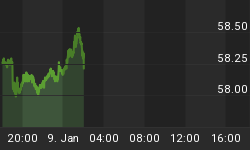Yen rises across the board as risk appetite takes a fresh hit following the latest evidence of the sub-prime mortgage spillover on the market and broader economy. JP Morgan Chase's downgraded the earnings of four of its competitors on the basis of lower higher write downs and lower M&A revenue. Meanwhile, downgraded and defaulted debt has reached towards state-run pension pools in Connecticut , Montana and Florida , with the latter owning more than $1 billion of downgraded paper.
Yesterday we made the fundamental case for a temporary rebound in the US dollar occurring on the heels of repositioning out of net dollar short positions, which initially favored EUR, GBP, AUD, NZD and CAD. The technical case for a temporary dollar rebound is seen in the following charts of Aussie and gold. USDJPY remains the exception to the dollar rebound story as the currency is anticipated to post fresh gains on the heels of prolonged equity market volatility.
Failure in S&P Technicals Pave Way for Fresh Downside
Last week's rebound in the S&P500 was as visible as its failure to break above the key 200-day moving average of 1485. The resounding sign of prolonged bearishness (as applicable to any technical chart) is seen not only through 3 consecutive weeks of trading below the 200-day MA, but two failed attempts to close above the 200 day MA . Fundamentally, the bear case for US equities further validated by the fact that last week's rally was largely a result of one-off factors, namely: Abu Dhabi Investment Authority's $7.5 bln purchase of 5% in Citigroup and increased indications by the Federal Reserve officials that a rate cut may be needed at the December 11 meeting.

Shaky Aussie Technicals in Line with Uncertain Equities
The Australian dollar may have been supported by a hawkish central bank raising interest rates last month and paving the way for further tightening. But the overnight figures on retail sales suggest the Reserve Bank of Australia may have to remain on hold for at least 2 months in order to assess whether the 50-bp tightening of the past 2 months combined with the strong currency is beginning to spillover to the economy. Australia 's retail sales rose 0.2% in October from September's 0.7% increase, undershooting estimates of a 0.6% increase. The report dragged the Aussie by more than half a cent to 0.8730.
We mentioned in yesterday's video commentary the developing head-and-shoulder formation in the AUDUSD, which is a common bearish reversal pattern. This suggests the pair could prolong weakness towards 0.8730, followed by 0.8670. A breach below the 0.8650 neckline is expected to extend losses towards the 200-day MA of 0.8570.

USDJPY capped at 110.80
We mentioned in yesterday's note that USDJPY was capped at 110.80 and retreat towards 110. Today's decline towards the 109.60 low may be expected to see follow up moves towards 109.25. Subsequent target stands at 108.30. The main risk to this move is a far stronger than expected non-farm payrolls release this Friday (above 110-120K). A 50-bp rate cut from the Fed next week would also likely boost the pair higher on the basis of an unexpected jolt of risk appetite weighing on the lowe yielding yen.

















